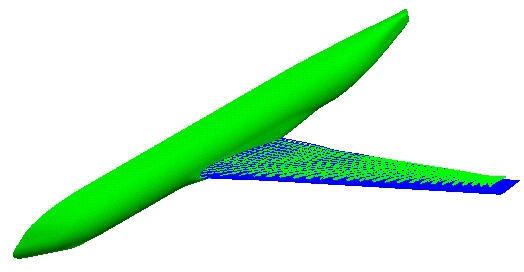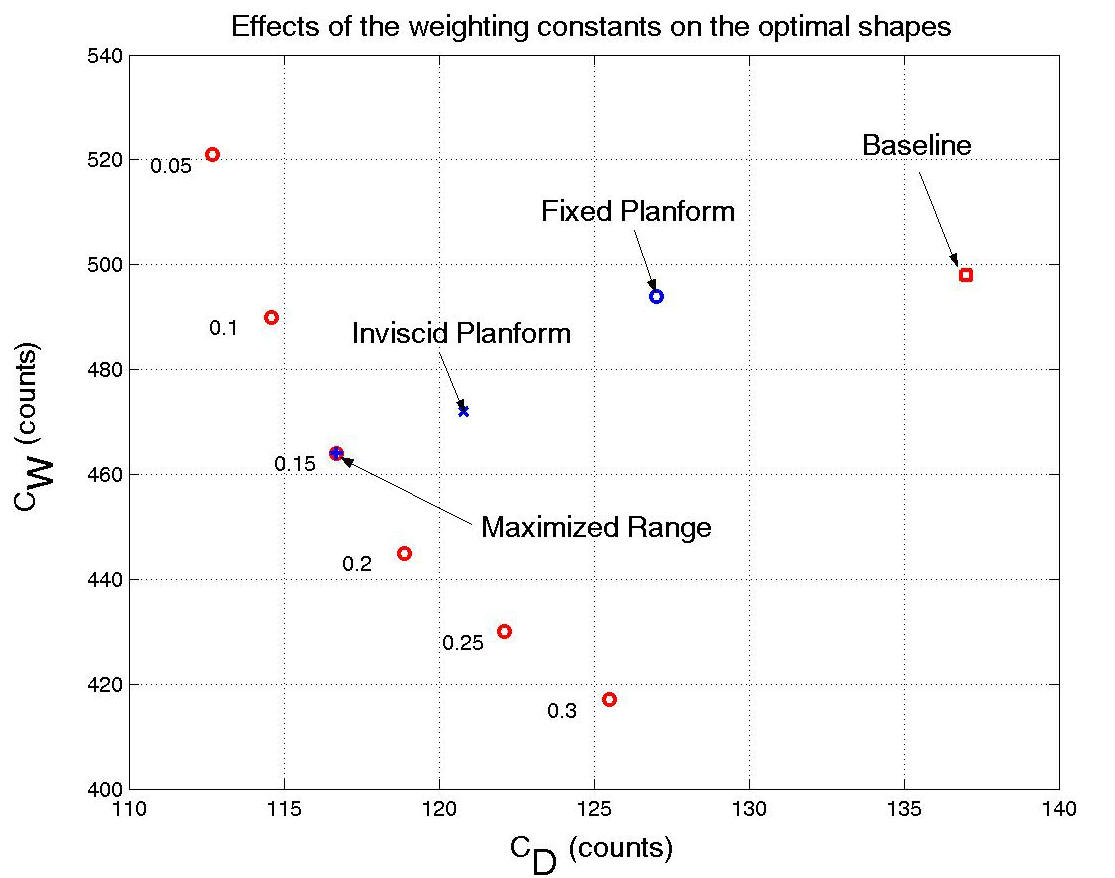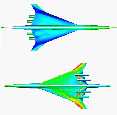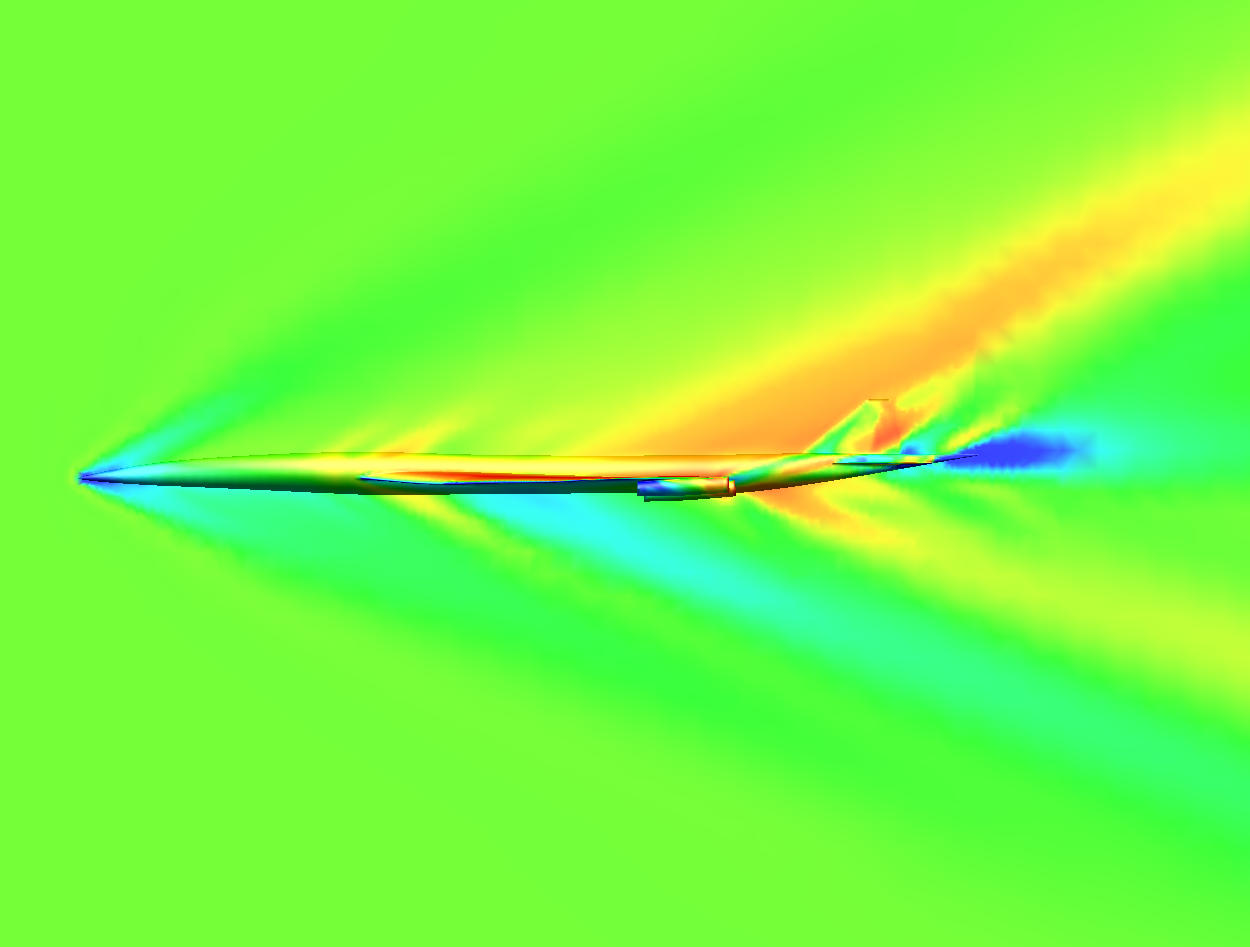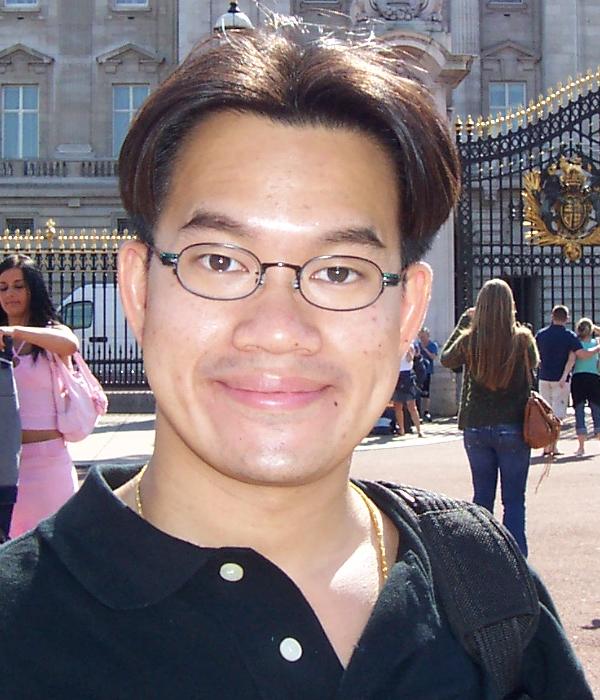
Research
![]()
Algebraic Multigrid for Finite Element Method
The focus of this work is to speed-up a solver, applied to a system of equation A.x = b. The matrix A arises from finite element method applied to the Navier-Stokes equation with unstructured grid. Due to stress terms, A is not symmetric. Current approach is to treat the linear equation as a black-box and incoporate multigrid to equation itself, not the geometry of the mesh.
Wing
Planform Optimization using an Adjoint Method
(Aug 2001 - March 2005)
 |
 |
| Green: Baseline planform Blue: Modified planform |
Simplified planform parameters; sweep, span, thickness, chords, and twist. |
This research was the focus of my
PhD dissertation. The description below is a summary from my dissertation.
Reader who is interested in this work may find my dissertation interesting and
is invited to download here.
"This research focuses on the problem of wing planform optimization for
transonic aircraft based on the solution of Computational Fluid Dynamics (CFD)
combined with an adjoint-gradient based numerical optimization procedure. It
exploits the shock-free-wing technology, extensively developed during the past
decade for wing section design, to ``cheat'' the conventional wisdom of the
planform design. The integration of the shock-free concept and planform
optimization enables a range of planform configurations previously prohibited by
the strong compressibility drag. This extended freedom can lead to a large
reduction in both structural weight and the induced drag.
In order to incorporate this idea, we employ the wing planform as well as the
wing sections as the design parameters. Because the two relevant disciplines are
aerodynamics and weight, we focus on the aerodynamic optimization with a
simplified structural weight model, treating a wing as fully-stressed and
rigid. This choice of cost function not only increases the reality of the design
but also prevents unrealistic results by exposing the trade-off between the
aerodynamics and structures. To formulate our design tool, we extend the
aerodynamic shape optimization tool that was initially developed for wing
section design to include the planform optimization. The original tool was
developed by combining CFD with gradient-based numerical optimization, and
applied the adjoint formulation to calculate gradients of a large number of
design parameters at very low computational cost, allowing the wing be treated
as a ``free'' surface to achieve a shock-free shape. Then we extend the adjoint
method to cover the planform variations and to compute the sensitivities of the
structural weight of both the wing section and planform variations.
Results of a variety of long range transports at fixed-altitude cruise
conditions indicate that significant improvement in both aerodynamics and
structures can be achieved simultaneously. They also reveal a similar trend from
these improvements; by utilizing the shock-free concept, the
compressibility drag can be weakened and thus the wing does not require as large
a sweep or as small a thickness-to-chord ratio as one that is
conventionally designed. The sweep reduction and thickness increment help reduce
structural weight, which can be traded for a longer span. The increase of span
reduces the induced drag, which is a large portion of drag at the cruise
condition, and therefore results in large drag reduction without a penalty on
the structural weight. Finally, inclusion of the structural weight and
area-dependent viscosity prevents any unrealistic result.
| Boeing 747 | BAe Datum Wing | Douglas MD-11 |
|
This figure shows a common pattern of planform changes on three long-range transport aircraft; Beoing 747, BAe datum wing, and Douglas MD-11. The baseline geometries are represented in green color and the modified geometries are in blue color. All modified wings have lower drag and wing weight. It has been found that by (1) stretching the span to reduce the induced drag, (2) de-sweeping the sweep and thickening the wing section to reduce the wing weight, and (3) using section modification to prevent shock formation, the drag and weight can be reduced simultaneously. |
||
This wing planform optimization is the ``first step'' in the right direction
beyond the pure aerodynamic shape optimization using the adjoint method for
fixed planform. The proof-of-concept optimal results indicate large
improvements for both drag and structural weight. The next step may require the
incorporation of a higher-fidelity structural model, which can capture
aero-elastic interaction and structure failure, and the implementations of
constraints to satisfy performance, stability-and-control, and manufacturing
requirements within the design envelope. It is important to note that additional
constraints will certainly affect the results presented here. Yet, the design
methodology presented in this work provides the basis for an extension to form a
more complete wing design tool."
|
This figure shows Pareto front of the Boeing 747. |
Quiet Supersonic Platform
(Mar 2001- Jul 2001)
"The Quiet Supersonic Platform (QSP) program is directed towards
development and validation of critical technology for long-range advanced
supersonic aircraft with substantially reduced sonic boom, reduced takeoff and
landing noise, and increased efficiency relative to current technology
supersonic aircraft. Improved capabilities include supersonic flight over land
without adverse sonic boom consequences with boom
During the time Kasidit joined this research, he focused on the so-called "Thomas Algorithm", which is employed to predict the strength of sonic boom at the ground level.
# http://www.darpa.mil/
Immersed Boundary
(July 2000 - Feb 2001)
It is clear that grid generation cost for a complex geometry is very high and it
is very time consuming to get a good quality grid. The idea of the project is to
create the fast and inexpensive Cartesian mesh throughout the domain,
intersecting the body. The body is immersed in the mesh. The key idea is to
apply a forcing term into Navier-Stokes equation as a source-sink in order for
the velocity to satisfy applied boundary conditions. Kasidit has discovered
that, with the extra forcing terms, he can force the flow to satisfy physics of
the problem at some degree of accuracy.
![]()



